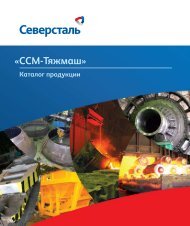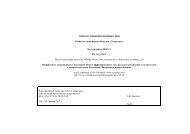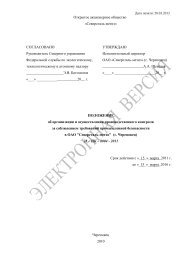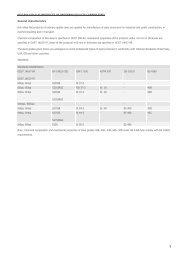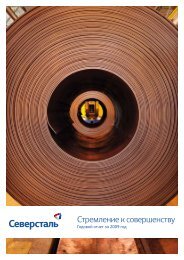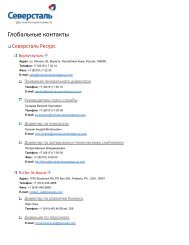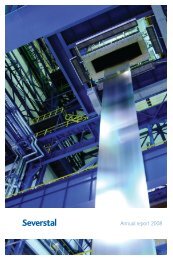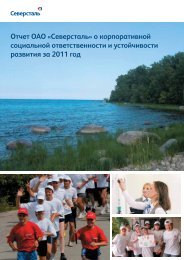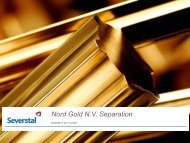Annual Report 2007 - Severstal
Annual Report 2007 - Severstal
Annual Report 2007 - Severstal
You also want an ePaper? Increase the reach of your titles
YUMPU automatically turns print PDFs into web optimized ePapers that Google loves.
Crude steel production<br />
Million tonnes<br />
<strong>2007</strong> 2006 Change Share in <strong>2007</strong><br />
year-on-year % %<br />
China 489.0 422.7 16 36<br />
EU27 210.3 206.8 2 16<br />
Japan 120.2 116.2 3 9<br />
USA 97.2 98.6 –1 7<br />
Russia 72.2 70.8 2 5<br />
India 53.1 49.5 7 4<br />
South Korea 51.4 48.5 6 4<br />
Ukraine 42.8 40.9 5 3<br />
Brazil 33.8 30.9 9 3<br />
Turkey 25.8 23.3 11 2<br />
Taiwan, China 20.5 20.0 2 2<br />
Mexico 17.2 16.3 6 1<br />
Canada 16.4 15.5 6 1<br />
Iran 10.1 9.8 3 1<br />
South Africa 9.1 9.7 –6 1<br />
Other 74.5 70.7 5 6<br />
Total 1,343.6 1,250.2 7 100<br />
Total, excluding China 854.6 827.5 3 64<br />
Source: International Iron and Steel Institute.<br />
Although raw materials contract prices increased only<br />
marginally around the world in <strong>2007</strong>, the supply of raw materials<br />
was unable to catch up with surging demand in the second half<br />
of the year. As a result, spot raw materials prices increased<br />
substantially – in certain cases by as much as 70%–150% –<br />
compared with 2006 levels. Price increases were acute for all the<br />
major raw materials costs of steelmaking, including coking coal,<br />
coke, iron ore and steel scrap.<br />
These price upgrades will be reflected in 2008 contract prices<br />
for iron ore and coal, contributing to a substantial increase in<br />
steelmaking costs in 2008. Price pressure from the raw materials<br />
market has highlighted the benefits of vertical integration and<br />
increased the level of strategic interest from steelmakers in<br />
upstream markets. Vertically integrated steelmakers like <strong>Severstal</strong><br />
are therefore in a stronger position regarding raw materials prices<br />
than those buying their iron ore and coal on the open market.<br />
Prices of hot-rolled flat metal products rose most steeply in<br />
Europe and Asia – growth of 15% in <strong>2007</strong>. In Russia, prices grew<br />
by 7%, while in the US they fell by 9%.<br />
Significant global price increases for long-rolled steel in <strong>2007</strong><br />
were due both to increased demand, and the growth in prices for<br />
scrap metal. The rates of price increases were particularly steep in<br />
Russia where beams were up by 51%, fixtures by 29%, and rolled<br />
wire by 33%.<br />
M&A and valuations<br />
Global consolidation in the steel industry continued in <strong>2007</strong> as<br />
steel companies aimed to expand their geographic presence,<br />
consolidate supply, and gain access to new markets and<br />
customers.<br />
M&A activity was particularly strong in North America where<br />
many of the remaining mid-sized companies were acquired by<br />
international majors from Europe and emerging markets. There<br />
was also a new trend: steel companies became increasingly<br />
interested in acquiring raw materials suppliers, including scrap<br />
collectors. For example, Nucor and Steel Dynamics, the two<br />
leading mini-mill steelmakers in North America, made substantial<br />
acquisitions of scrap companies operating in the US market.<br />
As further evidence of this trend, <strong>Severstal</strong> acquired Vtorchermet,<br />
a 1.1 million tonnes scrap collector in Russia.<br />
Increases in iron ore, coking coal and other bulk materials<br />
prices have prompted more M&A activity in the mining sector.<br />
Many leading steel companies made self-sufficiency in raw<br />
materials a key strategic priority.<br />
In this climate of continued consolidation, disciplined<br />
production behaviour and strong global demand for steel, the steel<br />
industry has benefited from increased attention from investors.<br />
The average EV/EBITDA multiple for the major publicly-traded<br />
steel companies has increased from less than five in 2006 to just<br />
over six in <strong>2007</strong>, reflecting increased investor confidence in the<br />
long-term sustainability of steelmakers’ earnings.<br />
This increase in multiples was particularly strong for Russian,<br />
Latin American and Asian companies as historical discounts were<br />
eliminated and higher long-term demand growth rates justified<br />
higher valuation. For markets like Russia, with relatively few<br />
opportunities to invest directly in infrastructure growth,<br />
investments in steel companies were seen as the gateway<br />
to the infrastructure and construction boom.<br />
Despite the recent consolidation activity, the steel<br />
industry remains much more fragmented than that of its<br />
suppliers (particularly iron ore), or its largest customers (such as<br />
automotive), or other metallurgic industries, such as Aluminium.<br />
Further takeovers, mergers and alliances are inevitable as<br />
producers look to integrate horizontally with other mills, and<br />
vertically with raw material suppliers and steel distributors, to<br />
secure their futures.<br />
<strong>Severstal</strong> <strong>Annual</strong> <strong>Report</strong> <strong>2007</strong> 27



